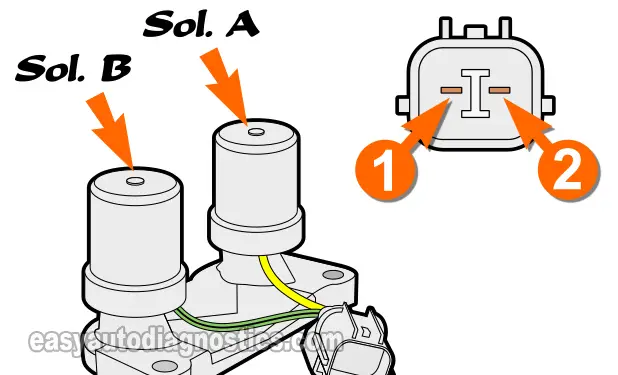TEST 2: Applying 12 Volts To TCC Solenoid A And B

There's a good chance that shift solenoid A and B passed TEST 1 with flying colors, but either solenoid could still be defective.
So our next test is to manually apply 12 Volts to terminal #1 and then to terminal #2 and see if each solenoid audibly clicks.
IMPORTANT: If you've removed the shift solenoid assembly from its place on your Honda CR-V's automatic transmission, you'll need to do one of two things: 1) bolt it back in place (on the transmission's case) or 2) Ground the solenoid assembly with a battery jump cable to Ground it (or this test won't work).
These are the test steps:
- 1
Disconnect the shift solenoid assembly from its electrical connector.
NOTE: This test is done on the shift solenoid assembly's connector which has male spade terminals AND NOT on the engine wiring harness pigtail connector. - 2
Apply 12 Volts to terminal #1 of the shift solenoid assembly's connector, using a jumper wire or a power probe.
- 3
You should hear an audible click coming from solenoid B when the 12 Volts are applied to terminal #1.
Repeat this test as many times as you need to be certain of your test results. - 4
Apply 12 Volts to terminal #2 of the shift solenoid assembly's connector, using a jumper wire or a power probe.
- 5
You should hear an audible click coming from solenoid A when the 12 Volts are applied to terminal #2.
Repeat this test as many times as you need to be certain of your test results.
Let's examine your test results:
CASE 1: You heard an audible click when applying 12 Volts to either solenoid. This is the correct and expected test result and tells you that the solenoids are opening and closing.
If your transmission is still not shifting, take a look at the suggestion found here: TCC Solenoid Assembly Is Good But Transmission Still Not Shifting.
CASE 2: An audible click WAS NOT heard when applying 12 Volts. This test result tells you that whichever shift solenoid did not audibly click is bad and needs to be replaced.
Replace the entire assembly to solve the issue.
TCC Solenoid Assembly Is Good But Transmission Still Not Shifting

If both lock-up solenoid valves are good and your Honda's transmission isn't slipping, yet a P1753 or P1758 keeps popping up, I want to suggest two things:
- Remove the lock-up solenoid assembly and clean the o-ring screens (see photo above). Some folks have reported that this has solved their issue with the TCC solenoids.
- Check the continuity of the wires between the solenoid assembly and the PCM. You'll need a wiring diagram of your specific Honda CR-V to accomplish this test.
In some cases there's a good chance that you'll have to replace the TCC lock-up solenoid assembly to completely eliminate it as the source of the problem. I know this isn't something you want to hear, but in some cases this is a necessary thing.
Now, if your Honda's transmission is slipping, then replacing the TCC solenoid assembly isn't gonna' help bring the transmission back to normal. Slippage is a direct result of internal damage to the friction discs or hard parts. The only way to solve a slippage issue is overhauling the transmission.
More 2.0L Honda CR-V Tutorials
You can find a complete list of tutorials here: Honda 2.0L Index Of Articles.
Here's a sample of the tutorials you'll find there:
- How To Test For A Blown Head Gasket (1997-2001 2.0L Honda CR-V).
- How To Test The Ignition Coil (1999-2001 2.0L Honda CR-V).
- How To Test The TPS (1997-2001 2.0L Honda CR-V).
- How To Test The MAP Sensor (1997-2001 2.0L Honda CR-V).
- How To Test Engine Compression (1997-2001 2.0L Honda).

If this info saved the day, buy me a beer!


